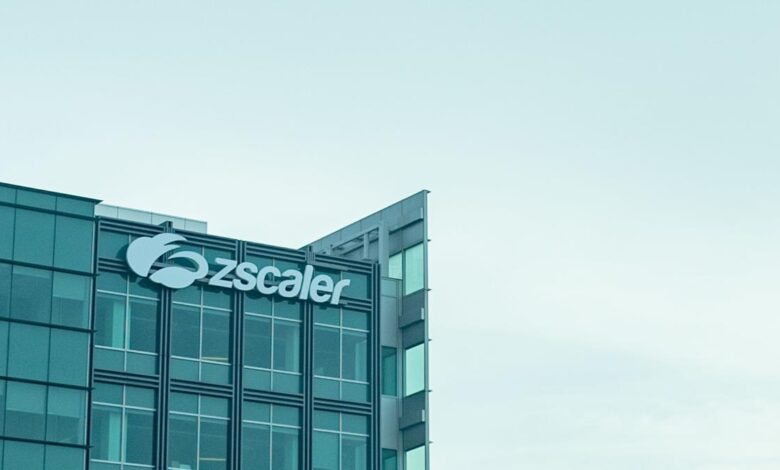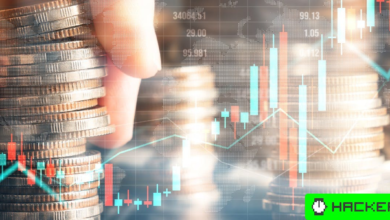CrowdStrike earnings, Zscaler and the cybersecurity landscape: Asking for a Trend

On Monday’s episode of Asking for a Trend, Yahoo Finance anchor Josh Lipton breaks down the stocks to watch this week, as CrowdStrike (CRWD), PVH (PVH), Stitch Fix (SFIX), Hewlett Packard Enterprise (HPE), and Bath & Body Works (BBWI) are all slated to report earnings on Tuesday.
Zscaler Chairman and CEO Jay Chaudhry also joins the show to discuss the company’s full-year guidance and the broader cybersecurity enterprise landscape.
This article was written by Gabriel Roy
Video Transcript
Hello and welcome to asking for a trend.
I’m Josh Lipton and for the next half hour going to be breaking down the trends of today that I move stocks tomorrow.
There’s a lot to keep track of.
So we’re focusing on what you need to know to get ahead of the curve.
Here are some of the trends.
We’re going to be diving into mean stocks reignited a reddit post reportedly from the stock leader, Keith Gill sparks a wide ranging rally but the Wall Street Journal reporting that E trade is considering removing him from the platform plus concerning that’s how the head of the NSA described cyber threats from China hackers.
In an interview with the Wall Street Journal, we’re going to be talking about the state of cyber security with the Scalers CEO that’s coming up next and major investments in A I mean a major uptick in energy use and as a result, more carbon dioxide released into our atmosphere.
We’re taking stock of the carbon removal landscape in our latest edition of next Z Scaler reporting a strong third quarter on the top and bottom lines.
Last week, the company also boosted its fiscal year guidance against the backdrop of more cautious guidance from peers in the cybersecurity sector for more.
We’re now bringing in Z Scaler Ceo Jay, Choudhry Jay.
It is good to have you on the show and you know, Jay, this is the first time we’ve had a chance to talk to you since you reported results, Jay, you reported, you beat the stock jumped, maybe start that there, Jay walk us through what drove the quarter?
So Cyber is the number one concern for Cio C sos and boats, but they also have to worry about cost savings.
Uh Market is tight.
There’s a lot of deal scrutiny.
C skier is a unique provider where we provide the best cyber security with zero trust architecture, but we also reduce cost because we eliminate a bunch of legacy security point products, firewalls, VPN S and more.
So that’s why we’re able to close business uh by doing both at the same time.
Hey Jay, it’s Julie here.
It’s good to see you.
Um You guys recently reported a cyber breach, I believe.
What can you tell us about that?
And did that have any kind of effect in the quarter or, or in the present quarter?
So there’s no breach per se.
There’s a claim breach, so to speak, the social media can do all kinds of stuff.
Yes, we, we did have uh an engineer trying to play with a new server in a Q environment, single machine that was out there discovered that was being set up.
So there’s a lot of basis for it.
There’s none to it.
We’re very transparent with customers.
We kept in communication but it had no impact.
Rather customers came and said, wow, you guys had great transparent communication.
We love it.
Jay.
When we have you, it’s always worth getting your kind of broader take on the threat landscape.
Jay, I mean, a lot of threats, rogue states, bad actors, criminal gangs, what are you seeing out there, Jay, they the two main areas, one the people who want to make money quick so ran somewhere on the rise and then there are nation states trying to steal secrets.
Those are the two big buckets and they are leveraging by getting on the network of the company moving laterally find high value assets and going after that.
So zero trust architecture is being clearly looked at as the primary solution for it.
The reason zero Zalar growth is happening is because companies are embracing zero trust architecture that we pioneered.
You talked about China just now the big threat from China is that all large companies who are present in China, they have a network coming from China all the way to the US or Europe.
Bad guys can get on the network in China travel and try to infect stuff out there.
We allow you not to have a network connected to China or other countries and still have secure communication.
Those are the type of things, enterprises and fed government organizations need to do to secure themselves.
And Jay, of course, um this is an election year, not only in the US, we just had an election in Mexico, we just had an election in India.
And I know that when you’re talking about breaches or insecure communications, that’s a very different issue than misinformation and disinformation.
But I’m just curious what you are seeing if anything sort of linked to geopolitics around the globe.
So we do track it though.
It’s not our primary focus.
We are seeing uptake of misinformation.
Uh uh We have a research team that actually tries to figure out what content is generated by Gen A I and what, what content is created by people.
It’s fascinating to see you can actually tell the difference and we’re seeing a lot more content that’s being put out, put out there that Gen A I is creating.
So all of us have to need, need to worry about it.
Jay, I wanna talk to you on, on competition real quickly and specifically Microsoft uh moving into your world.
You know, I I was checking with an analyst, Jay who covers uh the company and he was saying, listen that that is in his opinion, creating some noise in the market and on the street.
Um What are you seeing, Jay look, large companies like Microsoft, they want to expand in all areas, right?
So I’m not surprised that they’re trying to expand in our area.
They have had overlapping products for a while.
Microsoft Windows has VPN built in for a long, long time.
But when I talk to large enterprises, they asked for two things.
Number one, they said I want a security provider like a Switzerland who can equally support my security to access office 365 Azure, Aws GCP and scores of SAS applications.
We are in a better position to do that than an application provider like Microsoft number two, with all the issue you’re seeing out there with midnight blizzard.
I’m sure you saw the report that came from federal government about some of those issues.
More and more customers want application provider to be different from security provider, separation of applications and security is a better thing you don’t want a fox was the Henhouse Jay.
We always appreciate you coming on the show.
Thank you Josh and Julie.
Thank you for the opportunity.
Hope to talk to you again up next.
Diving into the trend of carbon renewal in our latest edition of next more.
Asking for a trend on the other side.
The rapid advancement in A I has accelerated energy usage for tech companies.
The surge has been so significant.
The IE A recently warned energy consumption from data centers A I and crypto would likely double in the next few years.
That’s put the importance of carbon removal in focus major tech companies are increasingly turning to the controversial process to offset carbon dioxide they can’t reduce on their own.
And one company is getting big backing from meta alphabet and JP Morgan Akiko Fujita takes a closer look for the latest episode of next.
So the first thing we’re gonna do is turn our spinner blades on.
You can already see a streak where we’ve already spread out there.
Rick Bennett is a third generation farmer trying his hand at a new type of fertilizer, crushed volcanic rock known as basalt.
The rock dust is considered waste but one start up is finding new use for it to tackle a climate crisis.
Workers here affectionately call this Brown Mountain lithos carbon considers it gold.
This material is what’s chemically reacting with carbon dioxide to permanently capture and sequester it into a form that takes it out of the atmosphere.
It’s a process that happens naturally over thousands of years.
Lithos carbon is spreading it on farms to accelerate it to two years backed by a $57 million investment from frontier.
A consortium of companies that includes Meta and JP Morgan.
There are some portions of company emissions that you will just never abate, recognizing that they have a net zero target and they want to actually get to zero and honor very public commitments.
They have to invest in some sort of removal.
Technology scientists say it’s not enough to reduce carbon emissions but capture them with co 21 of the leading causes of climate change, which is why hundreds of companies are pouring into the carbon removal space.
The question is, which can scale up quickly cheaply with the future of our environment at stake.
This is what’s next in carbon removal.
You’ve got drill rigs, prepping for the next shot.
We’ve got blasters in here, loading for a shot.
This quarry is so busy.
Uh We blast a couple of times a week out here and that could drop 50 to 60,000 tons of rock at a time onto the ground.
How far down are we?
Right now?
We’re about 100 ft down in this active pit state of North Carolina.
We can mine down to 500 ft deep.
So we’re gonna be here a very long time mining.
The, this fight against climate change begins with one of the most abundant resources on the planet.
Basalt has long been considered the building blocks used in asphalt and concrete.
Some rock quarry in North Carolina has so much of it.
It ships out millions of tons every year.
We take that 36 inch boulder and we crush it down to sand size particles that we can put in the asphalt and concrete.
And from that surge pile, it’ll get crushed again, it’ll get screened, it’ll get washed and it’ll kind of continue on that process until it gets to a final product size and spec and stockpiled some rock uses every piece of that rock, except the dust of waste that piles up in the end.
This is the secret, this is what we looked all over the country for.
Is this this particular material?
Not all the salt is quality that lithos wants.
Can you tell by just looking at it or do you actually have to?
You can’t.
Yeah.
So if we look at it under an electron microscope, we’re looking at all the properties that make it suitable for the carbon capture process and also release the nutrients that helps the soil and the plants grow in it as well.
It’s part of a process called enhanced rock weathering.
Carbon dioxide in the atmosphere combines with rainwater to create a weak form of acid rain that rain hits volcanic rocks.
It leads to a chemical reaction that traps CO2.
It’s a natural process that takes thousands of years.
Lithos carbon is speeding that up more than 1000 times by spreading the finest form of rock dust across farm fields.
The thinking is the more surface area, the rocks cover the more carbon is captured.
Li says all of the rain combined with the salt also helps improve crop yields.
Farms are extra special and extra powerful for a few reasons.
One the roots, they break up the rock dust faster.
So that’s great to the farmers already need to spread rock dust in their field.
They need to do this to rehabilitate their soils.
After we use synthetic Fizer, the farmers, they’re already spreading rock that we’re actually replacing something they already do today with something that works even better.
So it’s plugging into existing infrastructure, piggy backing on that and allowing us to scale this climate crisis faster.
So the drill goes in, it pulls the dirt right up into the bucket.
The soil is manually tested every two acres every six months to measure the amount of carbon captured enhanced rock weathering is one of many solutions in a growing industry with demand projected to quadruple from 2030 to 2040.
According to consulting firm BC G, there are already more than 220 carbon removal companies globally.
There’s multiple different pathways, chemical pathways for which you can take co two out of air and no one really knows for sure yet, which ones are going to be able to scale the fastest and come down the price curve most effectively.
And so it really starts to become a complicated puzzle of which technologies work in the right atmospheres or in the right uh environments to optimize all of this.
And we need some of all of them, this satellite image of carbon in the atmosphere points to the scale of the problem.
Humans have dumped two trillion tons of CO2 into the air, pushing global temperatures more than two degrees above pre industrial levels.
The UN panel on climate change says we need to remove up to 10 billion tons per year by 2050 to avoid the worst impacts of climate change.
That amounts to roughly 25% of annual carbon emissions today, that many of those emissions will be eliminated through various reduction measures.
So more efficient motors, cleaner power, et cetera, but there is still a large amount of emissions that ultimately will have to be taken out of the atmosphere in some way, if we want to get to net zero, that’s where carbon removal comes in.
Even with all of the efforts to decarbonize BCGs.
Current mystery estimates, companies will still fall more than 30% short of their goal to be truly net zero.
That means they will need to buy carbon credits from companies like lithos to offset emissions.
They can’t reduce on their own.
I think all of these sort of front runners in the carbon market, they are not just interested in what they can buy today.
They are investing in the future of the carbon di removed market, the scale of the problem they recognize that investment is needed.
So they are looking to kind of support pathways.
There are a lot of ways to remove carbon, but there’s a trade off between affordability and reliability.
Direct air capture has the simplest measuring system, but it requires building large factories that can suck co two out of the air.
It costs up to $1000 to capture a ton of carbon methods that rely on agricultural waste are considered cheaper, but it requires a lot of land enhanced rock weathering uses a smaller footprint.
But critics say there’s too much uncertainty.
There isn’t enough data to show how effective the process is planting trees may be economical.
But Mire says the carbon storage isn’t as permanent precise measurements are harder to come by.
You can estimate how much carbon is in the tree.
But there are questions like what happens if it gets cut down, what happens if there’s a forest fire.
And so in all of these technologies, they all have various pros and cons.
But in general, the higher quality ones or the higher durability ones are the ones that are closer to I can touch and feel and I can see this much has been removed and someone can put a stamp on it.
Another question related to that is what is the relative value or quality of the different credits, right?
Buyers want to have confidence that they are purchasing actual carbon that’s been removed.
They don’t want to purchase something and then find out they didn’t actually remove on their behalf.
It’s a big reason why companies with the most aggressive climate commitments are backing new technologies.
BC G estimates this market could reach as high as $135 billion by 2040 BC G has invested its own money signing partnerships with direct air capture companies like CLI works to remove more than 140,000 tons of Co two combined from the atmosphere.
Companies from alphabet to JP Morgan have invested more than $57 million in lithos as part of a consortium known as Frontier.
The funds agreed to buy 100 54,000 tons of carbon from lithos in the next few years, combined.
Frontiers committed to buying nearly a billion dollars of carbon.
By the end of the decade, we are moving so much material that anything that we can do to optimize the movement of that helps.
So part of these large optic agreements, what they allow us to do is start leveraging more efficient methods of transportation like rail or like barge.
Those methods can be extremely, extremely efficient, but you need to move a lot more minimum volume to get there.
Impact is still hard to quantify though companies are required to measure and verify carbon credits that are sold.
One of the most important things is that clear, MRV, the monitoring reporting and verification if you can clearly articulate and, and prove that you have captured a ton when you say you’ve captured a ton, but there’s not a universal standard right now.
Correct.
That’s correct.
And it gets really tricky when you start to look at different technologies with enhanced rock weathering, you basically you take rocks, you scatter them and these rocks will absorb co two.
And in these situations where you have the capture occurring over it could be acres, it could be thousands of acres.
You can’t possibly measure every single rock, right?
So how do you sample it and up with an agreed upon number, that is the removal that can then be sold.
Soil samples can point to the amount of co two captured on farms, but that carbon doesn’t stay locked up until it makes its way to the ocean where it’s sealed off for good.
So what you actually measure here is not necessarily ultimately what becomes the credit?
That’s correct.
Yeah, this is of the initial step in the process, right?
What we’re measuring here is exactly how fast the rock is dissolving in the field, how much carbon dioxide that is pulling down.
And then we look at all the downstream effects, we call it kind of like a trade or to grave accounting, right?
So we look at the effects here, we look at what’s happening in the rivers.
We also even model what’s happening in the oceans.
We take all of that into account before we kind of say, hey, here’s, here’s a ton of carbon that we’ve captured.
We’re doing custom application here.
Uh We’re actually applying um basalt and material here for another farmer, farmers like Rick Bennett are keeping a close eye on their fields.
Litho says the tiny rocks are helping improve crop yields by up to 57%.
In addition to handling and paying for every step of the process.
Lithos pays him, farmers get $50 an acre as part of the program what’s the result?
Then from a yield perspective, has it actually improved the quality of the soil?
Has it improved your yield?
We have only had one season with it on the land.
We truly in our test, didn’t see a yield increase last year, but we also did not lose any ground on our yield from the previous year.
So we’re excited to measure the results again.
This year, we think there will be definitely a yield increase.
Lithos expects to capture up to 50,000 tons of Co two on farms.
This year, hundreds of other farmers are waiting to partner with the company, but they’ll need to scale much more than that with demand for carbon credits, far outpacing existing supply in the market.
Our goal is in the next 3 to 4 years to get as much data as possible that allow us to go the full way models that allow us to say, hey, we know the soil types, you know the crop types, we know the climate, we see ourselves building something like the Google maps of enhanced weathering from there being able to scale down our measurement cost that really really to the whole lion’s share of profits at the moment scale down.
This cost, reach more farmers faster scale this up for society.
The need is so great, right?
We are at the kill a ton scale today, we need to get to the gig aon scale in the future.
That is a factor of a million growth today.
CD R is an optional thing and it’s starting to change, but until it becomes required, it’s only going to be limited to those who are willing to do it voluntarily.
The only way we can scale the, the technologies as fast as we need is if many of them succeed.
So this isn’t, I need deck and not trees.
This isn’t, I need enhanced rock weathering and not biochar.
This is I need all of it and I need all of them to scale the eu and the US have proposed guidelines to scrutinize the quality of carbon credits in the voluntary market.
But mire says mandating offsets are critical to bringing costs down a necessary step to getting companies to their net zero goals.
Lithos currently charges $370 a ton.
The goal is to slash that to 100.
So our goal is to be capturing billions of tons of carbon dioxide using enhanced rock weathering.
We know that’s possible.
Our goal is to really be at maybe 2 to 6 billion tons worldwide.
How many farms you need to spread this across?
How many acres of you need to cover to get to that goal.
It’s not even all of the world’s farming land is actually just a fraction of it.
So in America, if we just focus alone on corn and soybean crops, and there’s many other things we grow, obviously.
But if we just focus on that alone, we believe we could capture up to 0.7 gigatons so 700 million tons of carbon dioxide.
So that’s the key time now for to watch Tuesday, June 4th.
We’re gonna be getting the first look at the labor market this week ahead of Friday’s jobs report.
The latest jolts report for April is at a 10 a.m. Eastern economist.
Forecasting job openings will decline from March which was its lowest level in more than three years on the earnings front.
We’re gonna get results from crowd strike PV H and stitch fix crowd track announcing first quarter results after the close and its expecting the company’s annual recurring revenue growth to stay above 30% driven by its ad on products.
Also on deck Hewlett Packard Enterprise and Bath and body works H pe reporting second quarter earnings after the bell tomorrow, corner analyst, the company is expected to deliver big gains from A I servers.
That’s a wrap on today’s asking for a trend.
Be sure to come back tomorrow at 4:30 p.m. Eastern for all of the latest market.
Moving stories affecting your wallet.
Have a great day.



